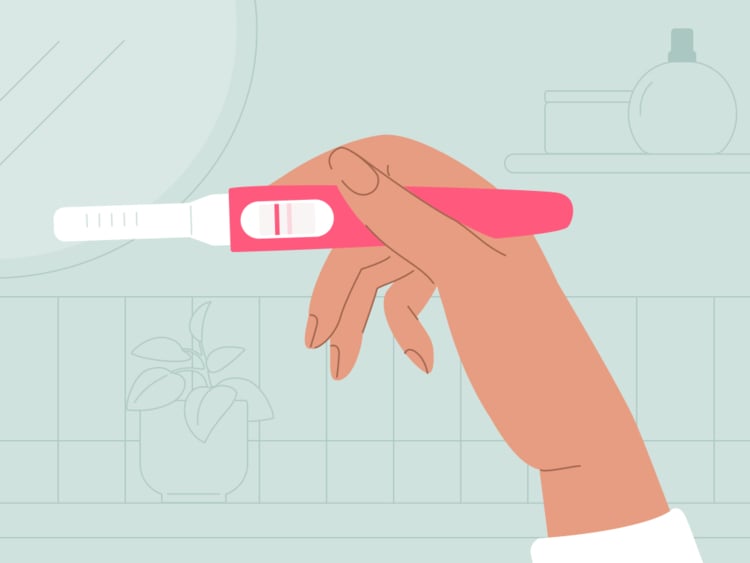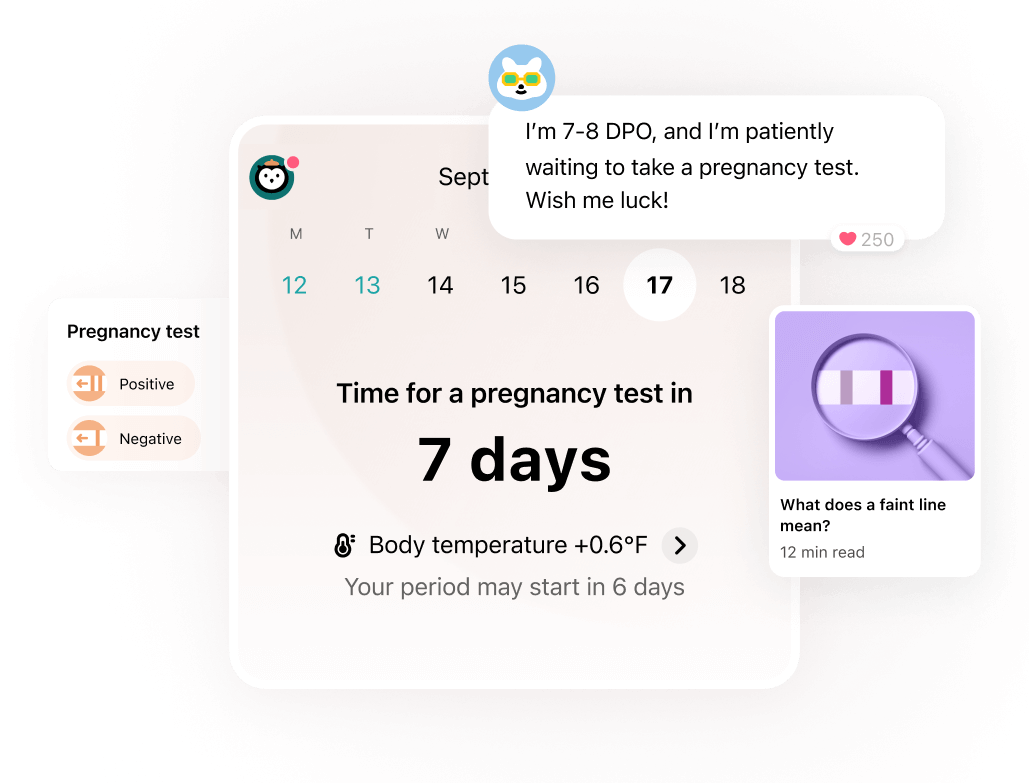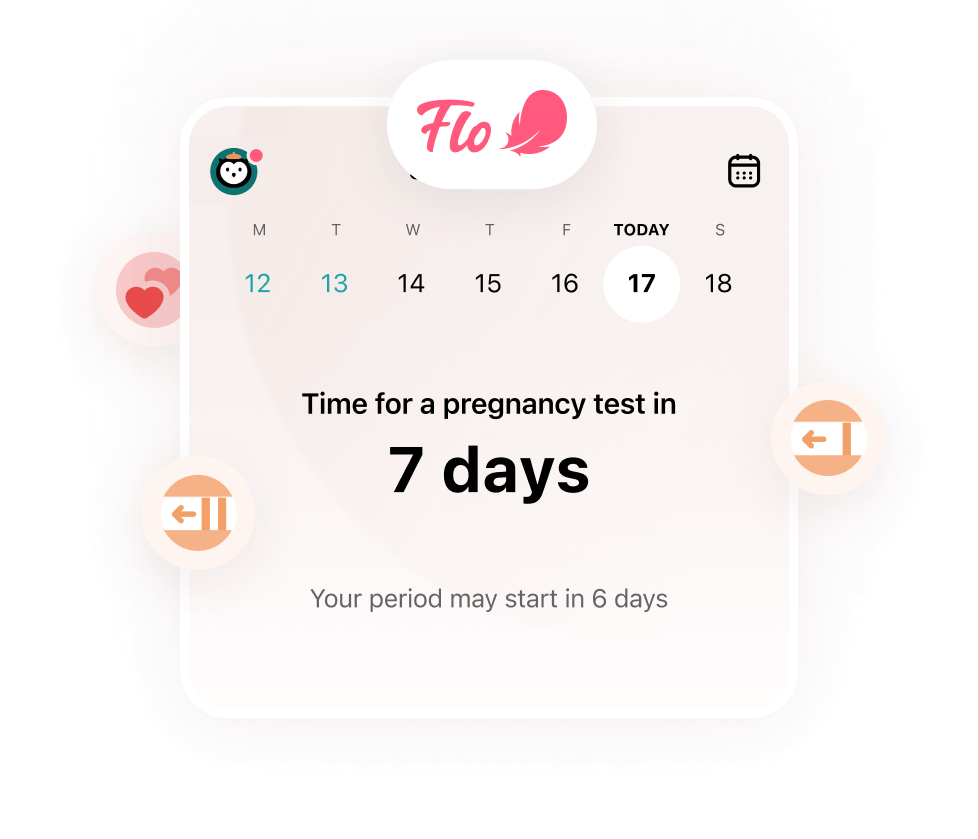Whether you’re trying to conceive or not, taking a pregnancy test is a moment when you want clarity. Is it positive or not? Here’s the lowdown on faint lines on pregnancy tests.
-
Tracking cycle
-
Getting pregnant
-
Pregnancy
-
Help Center
-
Flo for Partners
-
Anonymous Mode
-
Flo app reviews
-
Flo Premium New
-
Secret Chats New
-
Symptom Checker New
-
Your cycle
-
Health 360°
-
Getting pregnant
-
Pregnancy
-
Being a mom
-
LGBTQ+
-
Quizzes
-
Ovulation calculator
-
hCG calculator
-
Pregnancy test calculator
-
Menstrual cycle calculator
-
Period calculator
-
Implantation calculator
-
Pregnancy weeks to months calculator
-
Pregnancy due date calculator
-
IVF and FET due date calculator
-
Due date calculator by ultrasound
-
Medical Affairs
-
Science & Research
-
Pass It On Project New
-
Privacy Portal
-
Press Center
-
Flo Accuracy
-
Careers
-
Contact Us
A faint line on a pregnancy test: What does it mean?


Every piece of content at Flo Health adheres to the highest editorial standards for language, style, and medical accuracy. To learn what we do to deliver the best health and lifestyle insights to you, check out our content review principles.
Key takeaways
- A faint line on a pregnancy test could mean that you’re pregnant.
- At-home pregnancy tests work by detecting the presence of human chorionic gonadotropin (hCG), aka the “pregnancy hormone,” in your pee. Some at-home tests can pick up hCG in your pee sooner than others.
- You can avoid getting a faint positive pregnancy test by waiting until the first day of a missed period before taking a test and following all of the instructions in the box.

 Over
7.8M
ratings averaging
4.8/5
*
Over
7.8M
ratings averaging
4.8/5
*
Make sense of pregnancy testing with the Flo app
- Know when it’s the right time to take a test.
- Log results of previous pregnancy tests.
- Chat with others who are trying.
 Over
7.8M
ratings averaging
4.8/5
*
Over
7.8M
ratings averaging
4.8/5
*

Hoping for a positive pregnancy test?
The Flo app can help you on your path to parenthood.

 Over
7.8M
ratings averaging
4.8/5
*
Over
7.8M
ratings averaging
4.8/5
*
Make sense of pregnancy testing with the Flo app
- Know when it’s the right time to take a test.
- Log results of previous pregnancy tests.
- Chat with others who are trying.
What does a faint line mean on a pregnancy test?
Taking a pregnancy test can be overwhelming, especially when you’re having a hard time deciphering the results. Seeing a faint line can make it tough to tell if the test is positive or negative, as the line may not be as clear as you expected.
If you see a faint line, it could mean that you’re very early on in your pregnancy, that your pee was too diluted to get an accurate result, or that you experienced a chemical pregnancy (a very early miscarriage before five weeks). Getting unclear results from a pregnancy test can be extremely frustrating and leave you with more questions than answers. So, here’s the lowdown on how you can avoid getting a faint line on a pregnancy test, along with what it might mean.
A faint positive vs. an evaporation line
You might have heard about the evaporation line on a pregnancy test and been curious if a faint line is the same thing. The short answer is it isn’t. An evaporation line can show up when the pee on the test area dries up. If you wait too long to check your pregnancy test results, you might mistake an evaporation line for a very faint positive pregnancy test, but they are two different things.
Can a faint line mean a negative result?
If you see any kind of second line, even if it’s very faint, there’s a good chance that you could be pregnant. That’s because the pregnancy test detects human chorionic gonadotropin (hCG), dubbed the “pregnancy hormone,” in your pee. Your body starts to produce hCG after an embryo (fertilized egg) has implanted into the wall of your uterus and your placenta has started to develop. A barely visible line usually means that hCG has been detected and, therefore, you could be pregnant. You might mistake the evaporation line on a pregnancy test as a true second line, in which case, you might receive a false positive, but this is pretty rare.

How to take a home pregnancy test
If you’re planning to take a home pregnancy test, there are some things you should keep in mind to make sure you get the most accurate results possible. It turns out that it’s not as easy as “just peeing on a stick.”
First, check the expiration date before you open the packaging. Then, make sure to carefully read the instructions that come with your test since they may be different from other tests you’ve taken before. Depending on the test, you may need to pee directly onto the testing stick, pee in a container and dip the test in it, or drip a little bit of pee on the test. Try to follow the instructions as closely as possible because user error is often to blame for inaccurate results.
You can take a pregnancy test at any point in the day — morning, noon, or night. However, it’s worth considering that you may have drank lots of liquids during the day to stay hydrated, and your pee may be more diluted as the day goes on. That’s why it’s usually best to take a pregnancy test when you have a full bladder or during your first pee of the day. Then comes the hardest part! Once you’ve taken the test, be patient. It takes a few minutes for the result to appear, so be sure to check the test within the recommended time frame — not sooner or later. It can be tempting to peek, but for the most accurate results, it’s best to wait the recommended period of time. You can learn more about what at-home pregnancy tests are looking for using an app like Flo.
Interpreting a pregnancy test
When you take a home pregnancy test, you’ll usually see two lines on the display: a control line and a test line.
The control line is darker and shows that the test is working properly. The test line detects hCG, which is usually only present in the body during pregnancy. You’ll see the control line first, which confirms that the test is working. If this line doesn’t appear, it’s best to throw the test away as it might not give accurate results.
The second line is the test line and will only appear if there’s enough hCG in your pee to detect. Different tests might show results in different ways, such as a blue or pink line or a plus or minus sign. Digital pregnancy tests don’t show lines, but rather, they display a message that says “pregnant” or “not pregnant,” so some people find them easier to use. Whichever test you use comes down to personal choice; neither is “better” than the other.
What could cause a faint line on a pregnancy test?
So, what does a faint line on a pregnancy test mean? The strength of the positive test line depends on how much hCG is in your pee, and a few things can affect that. Here are a few reasons you might see a faint line on a pregnancy test.
It’s a little too early
HCG levels can be low if you’re in the early stages of pregnancy. Although some pregnancy tests claim to be up to 99% accurate on the first day of a missed period, this is if the pregnancy test is taken correctly, and they’re not as reliable in the earliest stages of pregnancy. Some pregnancy tests are also more sensitive to hCG levels than others, meaning they can pick up lower levels of hCG earlier in your cycle, which may mean you get a faint line on your pregnancy test. HCG increases during pregnancy, so if you see a faint positive line on a pregnancy test, it may become more visible if you test again in a day or two.
Your urine is too diluted
A very faint line may also happen if your pee is too diluted to detect hCG, which can happen when you’ve been drinking fluids throughout the day. That’s why taking a pregnancy test first thing in the morning when your pee is more concentrated might give you a clearer result.
That said, Dr. Jenna Flanagan, assistant professor of obstetrics and gynecology, University of Utah, US, says you shouldn’t stress too much about timing because using a sample from later in the day can “hypothetically delay a positive result by only 12 to 24 hours.”
Take a quiz
Find out what you can do with our Health Assistant
Fertility medication
If you’re going through fertility treatment and taking certain medications, those drugs may contain hCG. This could lead to a positive result if you take a pregnancy test. To avoid any confusion or uncertainty, it’s best to wait between nine to 14 days after taking your medication before you test for pregnancy. Your health care provider will be able to advise you. That way, you can be sure that all of the hCG in your fertility medication has fully cleared from your system and that the hCG your test is detecting is from your pregnancy.
Pregnancy complications
Very early miscarriage
A faint positive pregnancy test could indicate a chemical pregnancy, which is a type of miscarriage that happens within the first five weeks of pregnancy.
During a chemical pregnancy, the embryo begins to form and may even implant in the uterus but then stops developing. A chemical pregnancy can cause a false positive result or a faint line on a pregnancy test because the body may produce and release a small amount of hCG.
Please know that early miscarriages are quite common and often go unnoticed, and most people who experience early-stage miscarriages and try to get pregnant again go on to have successful, full-term pregnancies. That said, miscarriage can be heartbreaking, so make sure you get the support you need to process what has happened.
Ectopic pregnancy
In extremely rare cases, an embryo may attach outside of the uterus — most often in the uterine tubes. This is known as an ectopic pregnancy. Despite being outside of the uterus, ectopic pregnancies still produce the hormone hCG, which can lead to a positive result on a home pregnancy test.
However, it’s important to remember that ectopic pregnancies only occur in around 2% of pregnancies — and they’re unlikely to be the cause of a faint line on a pregnancy test. If you get a positive pregnancy test result and happen to experience any of these symptoms, please contact your health care provider right away:
- Pain in your lower abdomen, especially if you feel it more on one side
- Bleeding from your vagina
- Brown watery discharge from your vagina
- Pain in the tip of your shoulder
- Discomfort when peeing and/or pooping
- Dizziness or fainting
What to do if there’s a really faint line on a pregnancy test
Unclear pregnancy test results can be really stressful, but try not to worry too much! There are many reasons why the results might not be straightforward — including user error. In that case, taking a second test will do the trick. You might also try taking the test again in a few days to see if anything changes.
If you keep seeing a very faint positive pregnancy test, it’s a good idea to talk to your health care provider. They can do a blood test for hCG and may order an ultrasound of your uterus to confirm whether you’re pregnant or not. Your provider can also help explain why the first test wasn’t clear.
Tips on how to avoid getting a faint line on pregnancy tests
Try these tips to avoid getting a faint line on a pregnancy test:
- Read (and follow) the instructions carefully. Not all pregnancy tests can be taken the same way — some need you to pee directly on the stick, while others ask you to pee in a container and dip the test in it or to drop some pee onto the test. Plus, some tests are more sensitive than others, meaning they can pick up lower levels of hCG earlier in your cycle. It’s worth thoroughly reading the information pamphlet to find out how yours works before you test.
- Store the test in a dry place. Try to avoid storing the test in warm or damp areas, like your bathroom, since this can affect its reliability.
- Take the test first thing in the morning. This is when your hCG levels are more concentrated, so you’re less likely to see a faint line.
- Don’t drink too many liquids. If you’re excited to take the test, you might be tempted to drink loads of water to go to the bathroom, but that could dilute your hCG levels and cause a faint line.
- Use a digital test. They’re a bit pricier, but digital pregnancy tests have a screen to display the words “pregnant” or “not pregnant” instead of lines, so there’s less room for confusion.
FAQs
How common is a faint line on a pregnancy test?
It is pretty rare to see a faint line if you are not pregnant. Remember that even the faintest line can mean that you’re pregnant, but it’s worth doing another test to be sure.
How long after a faint positive should I test again?
If you carefully followed the instructions, it could mean that you took the test too early in your pregnancy. If you see a faint line and aren’t sure whether you’re pregnant or not, wait a couple of days before testing again.
Will a faint positive get darker as it dries?
For the most part, the lines on a pregnancy test don’t get darker as they dry. That’s because how dark or faint they look depends on the level of hCG detected, not the amount of pee. To avoid confusion, check the result only in the time recommended on the test instructions.


Hey, I'm Anique
I started using Flo app to track my period and ovulation because we wanted to have a baby.


The Flo app helped me learn about my body and spot ovulation signs during our conception journey.


I vividly
remember the day
that we switched
Flo into
Pregnancy Mode — it was
such a special
moment.
Real stories, real results
Learn how the Flo app became an amazing cheerleader for us on our conception journey.
References
Betz, Danielle, and Kathleen Fane. “Human Chorionic Gonadotropin.” StatPearls, StatPearls Publishing, 2023, www.ncbi.nlm.nih.gov/books/NBK532950/.
“Chemical Pregnancy.” Cleveland Clinic, my.clevelandclinic.org/health/diseases/22188-chemical-pregnancy. Accessed 31 Aug. 2023.
“Doing a Pregnancy Test.” NHS, www.nhs.uk/pregnancy/trying-for-a-baby/doing-a-pregnancy-test/. Accessed 31 Aug. 2023.
“Ectopic Pregnancy.” NHS Inform, 13 Dec. 2022, www.nhsinform.scot/illnesses-and-conditions/pregnancy-and-childbirth/ectopic-pregnancy.
“Ectopic Pregnancy.” Cleveland Clinic, my.clevelandclinic.org/health/diseases/9687-ectopic-pregnancy. Accessed 31 Aug. 2023.
“Ectopic Pregnancy.” The American College of Obstetricians and Gynecologists, Feb. 2018, www.acog.org/womens-health/faqs/ectopic-pregnancy. ]
“Ectopic Pregnancy.” NHS, www.nhs.uk/conditions/ectopic-pregnancy/diagnosis/. Accessed 31 Aug. 2023.
Gnoth, C., and S. Johnson. “Strips of Hope: Accuracy of Home Pregnancy Tests and New Developments.” Geburtshilfe und Frauenheilkunde, vol. 74, no. 7, July 2014, pp. 661–69, doi:10.1055/s-0034-1368589.
“Human Chorionic Gonadotropin, HCG Injection.” Cleveland Clinic, my.clevelandclinic.org/health/drugs/18559-human-chorionic-gonadotropin-hcg-injection. Accessed 31 Aug. 2023.
“Home Pregnancy Tests: Can You Trust the Results?” Mayo Clinic, 23 Dec. 2022, www.mayoclinic.org/healthy-lifestyle/getting-pregnant/in-depth/home-pregnancy-tests/art-20047940.
“Human Chorionic Gonadotropin.” Cleveland Clinic, my.clevelandclinic.org/health/articles/22489-human-chorionic-gonadotropin. Accessed 31 Aug. 2023.
Makrigiannakis, Antonis, et al. “The Role of HCG in Implantation: A Mini-Review of Molecular and Clinical Evidence.” International Journal of Molecular Sciences, vol. 18, no. 6, June 2017, https://doi.org/10.3390/ijms18061305.
“Pregnancy Test.” MedlinePlus, medlineplus.gov/lab-tests/pregnancy-test/. Accessed 31 Aug. 2023.
“Pregnancy Test Instructions.” UNC School of Medicine, www.med.unc.edu/timetoconceive/study-participant-resources/pregnancy-test-instructions/. Accessed 31 Aug. 2023.
“Pregnancy Tests.” Cleveland Clinic, my.clevelandclinic.org/health/articles/9703-pregnancy-tests. Accessed 31 Aug. 2023.
“What Is a Chemical Pregnancy?” Penn Medicine Lancaster General Health, www.lancastergeneralhealth.org/health-hub-home/motherhood/getting-pregnant/what-is-a-chemical-pregnancy. Accessed 31 Aug. 2023.
Wu, Yixuan, and Haiying Liu. “Possibility of Live Birth in Patients with Low Serum β-hCG 14 Days after Blastocyst Transfer.” Journal of Ovarian Research, vol. 13, no. 1, Nov. 2020, p. 132, https://doi.org/10.1186/s13048-020-00732-6.
History of updates
Current version (26 September 2023)
Published (17 January 2019)
In this article

Get your personal guide to fertility
-
Learn how to read your body's ovulation signals
-
Find daily conception tips from our experts
-
Chat with others who are trying to get pregnant




